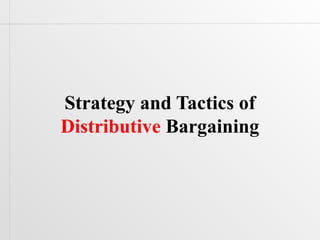
Week_3_4_ppts
- 1. Strategy and Tactics of Distributive Bargaining
- 2. Time to Negotiate…. The Car Dealers Game
- 4. The Distributive Bargaining Situation • Goals of one party are in fundamental, direct conflict to another party • Resources are fixed and limited • Maximizing one’s own share of resources is the goal
- 5. The Distributive Bargaining Situation Preparation—set a • Target point, aspiration point • Walkaway, resistance point • Asking price, initial offer
- 6. The Distributive Bargaining Situation Party A - Seller Walkaway Point Target Point Asking Price Initial Offer Target Point Walkaway Point Party B - Buyer
- 7. The Role of Alternatives to a Negotiated Agreement • Alternatives give the negotiator power to walk away from the negotiation – If alternatives are attractive, negotiators can: • Set their goals higher • Make fewer concessions – If there are no attractive alternatives: • Negotiators have much less bargaining power
- 8. The Distributive Bargaining Situation Party A - Seller Walkaway Point Target Point Asking Price Alternative Alternative Initial Offer Target Point Walkaway Point Party B - Buyer
- 9. Fundamental Strategies • Push for settlement near opponent’s resistance point (extreme offers, small concessions) • Get the other party to change their resistance point (eg. say it is overpriced) • If settlement range is negative, either: – Get the other side to change their resistance point – Modify your own resistance point • Convince the other party that the settlement is the best possible (ego satisfaction )
- 10. Keys to the Strategies The keys to implementing any of the four strategies are: • Discovering the other party’s resistance point • Influencing the other party’s resistance point
- 11. The other’s understanding of your own situation • Higher the estimation of your cost of delay or impasse (termination) – higher RV • Higher the estimation of his cost of delay or impasse – lower RV • The less the other party values an issue –lower RV • The more the estimation of the value of an issue for you –lower RV
- 12. Tactical Tasks of Negotiators • Assess outcome values and the costs of termination for the other party • Manage the other party’s impressions • Modify the other party’s perceptions • Manipulate the actual costs of delay or termination
- 13. Assess Outcome Values and the Costs of Termination for the Other Party • Indirectly – Determine information opponent used to set: • Target • Resistance points • Directly – Opponent reveals the information
- 14. Manage the Other Party’s Impressions • Screen your behavior: – Say and do as little as possible (Silence is golden!) • Direct action to alter impressions – Present facts that enhance one’s position
- 15. Modify the Other Party’s Perceptions • Make outcomes appear less attractive • Make the cost of obtaining goals appear higher • Make demands and positions appear more or less attractive to the other party –whichever suits your needs
- 16. Manipulate the Actual Costs of Delay or Termination • Plan disruptive action – Raise the costs of delay to the other party (eg. strike) • Form an alliance with outsiders – Involve (or threaten to involve) other parties who can influence the outcome in your favor • Schedule manipulations – One party is usually more vulnerable to delaying than the other (eg. reschedule, give shorter time to decide)
- 17. Positions Taken During Negotiations • Opening offer – Where will you start? (anchoring!!!) • Opening stance – What is your attitude? • Competitive? Moderate? • Initial concessions – Should any be made? If so, how large?
- 18. Positions Taken During Negotiations • The role of concessions – Without them, there is either capitulation or deadlock • Patterns of concession making – The pattern contains valuable information (make lower concessions to signal that you are approaching your RV) • Final offer (making a commitment) – “This is all I can do”
- 19. Closing the Deal • Provide alternatives (2 or 3 packages) • Assume the close • Split the difference • Exploding offers (offer is relevant for a short period) • Deal sweeteners
- 20. Dealing with Typical Hardball Tactics • Four main options: – Ignore them – Discuss them (“I know what you are doing”) – Respond in kind – Co-opt the other party (befriend them)
- 21. Typical Hardball Tactics • Good Cop/Bad Cop • Lowball/Highball – ridicolously low (high) opening – The other party: “A waste of time” – Ask for a more reasonable opening • Bogey (playing up an issue of little importance) • The Nibble (asking for a number of small concessions to) eg. A scarf to go with the dress
- 22. Typical Hardball Tactics • Chicken (bluffing) • Intimidation (anger, guilt, legitimacy) • Aggressive Behavior • Snow Job (overwhelm the other party with information)
- 23. Summary Negotiators need to: • Set a clear target and resistance points • Understand and work to improve their BATNA • Start with good opening offer • Make appropriate concessions • Manage the commitment process